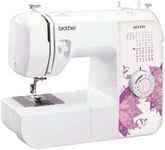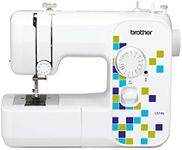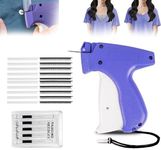Buying Guide for the Best Hand Held Sewing Machines
Hand-held sewing machines are compact, portable devices designed for quick and easy sewing tasks. They are ideal for small repairs, alterations, and on-the-go sewing needs. When choosing a hand-held sewing machine, it's important to consider the specific features that will best suit your sewing projects and personal preferences. Understanding the key specifications will help you make an informed decision and ensure that the machine you choose meets your needs effectively.Stitch TypesStitch types refer to the different patterns a sewing machine can create. In hand-held sewing machines, the variety is usually limited compared to full-sized machines, often offering a basic straight stitch. This is important because the type of stitch determines the kind of sewing tasks you can perform. If you only need to do simple repairs or hems, a basic straight stitch will suffice. However, if you anticipate needing more decorative or specialized stitches, you might need to look for a machine that offers additional stitch options, though these are rare in hand-held models.
Power SourceThe power source of a hand-held sewing machine can be either battery-operated or electric (plug-in). This is crucial as it affects the machine's portability and convenience. Battery-operated machines are highly portable and can be used anywhere, making them ideal for travel or quick fixes away from home. Electric machines, on the other hand, may offer more consistent power but require access to an electrical outlet. Consider where and how you plan to use the machine to determine which power source is more suitable for your needs.
Fabric CompatibilityFabric compatibility refers to the types of materials a sewing machine can handle. Hand-held sewing machines are generally designed for lightweight fabrics such as cotton or polyester. This is important because using the machine on fabrics it cannot handle can lead to poor stitching or damage to the machine. If you plan to sew heavier materials like denim or canvas, ensure the machine is rated for such fabrics. For most casual users, a machine that handles basic fabrics will be sufficient.
Ease of UseEase of use encompasses how simple the machine is to operate, including threading, stitch selection, and maintenance. This is important because a machine that is difficult to use can be frustrating and may discourage you from completing your projects. Look for a machine with clear instructions and intuitive controls. If you're a beginner, prioritize models that are known for their user-friendly design. Experienced users might be comfortable with more complex machines, but simplicity is often beneficial for quick tasks.
Size and WeightThe size and weight of a hand-held sewing machine affect its portability and storage. This is important if you need a machine that you can easily carry with you or store in a small space. Lighter and more compact machines are easier to handle and transport, making them ideal for travel or occasional use. If you plan to use the machine frequently at home, a slightly larger model might offer more stability and comfort during use. Consider your typical usage scenarios to decide the right balance of size and weight for you.













